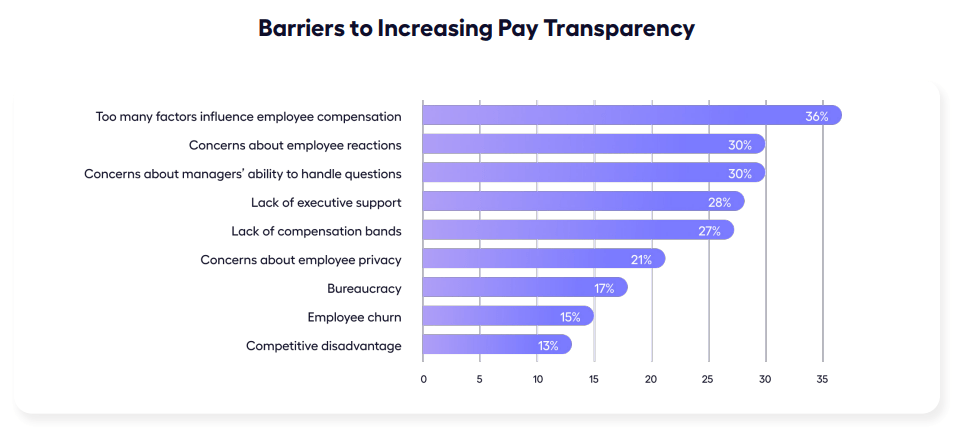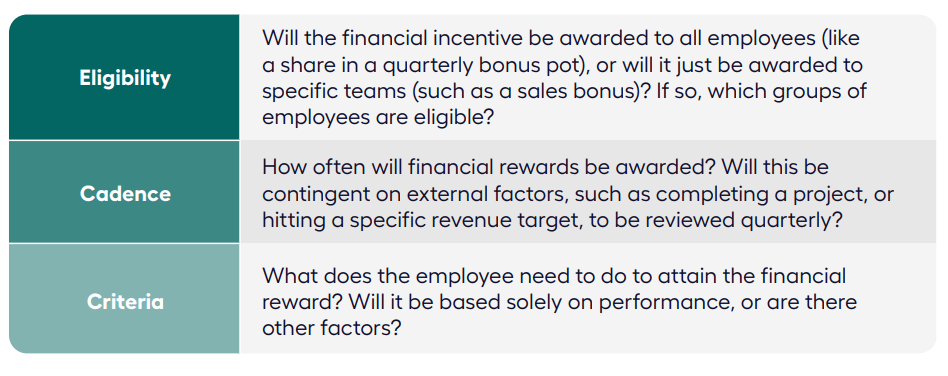At the beginning of 2023, California, Rhode Island, and Washington joined the expanding group of US states that have adopted pay transparency regulations, requiring companies to disclose pay range information in job postings. This move follows in the footsteps of Colorado, Maryland, Connecticut, and New York City, which have enacted similar laws in recent years.
The push towards pay transparency is presenting significant challenges for companies as they struggle to adapt to the new requirements. For instance, in California, only a quarter of technology companies was in compliance with the new law when it came into effect on January 1st, 2023. However, this number has risen to 61%, indicating slow but steady progress toward compliance.
With limited guidance, employers face criticism for the wide range of salary information they provide, which can differ by tens of thousands of dollars. Companies have resorted to exploiting loopholes for this new law, which undermines its intent. For example, a job listing for Netflix states that a software engineer based in Los Gatos, California, can earn anywhere from $90,000 to $900,000. Similarly, Tesla’s job listing states that a program manager based in Fremont, California, can make anywhere from $68,000 to $222,000.
Despite the slow adoption by employers and lack of clear guidelines, the shift towards pay transparency is inevitable. This guide aims to help employers navigate these changes, comply with the regulations, and implement best practices for pay transparency moving forward as the guidelines continue to develop.
What Is Pay Transparency?

Pay transparency is the practice of employers sharing salary information with current and prospective employees. Companies can engage in different forms of pay transparency, depending on state laws and the organization’s compensation philosophy.
For example, recent legislation requires employers based in New York City to document a “good faith salary range” for job postings, which is intended to be a fair estimate of the salary that will be offered to whoever is selected for the position.
The benefits of pay transparency include:
- Fair And Efficient Hiring Processes: Pay transparency ensures that candidates are provided with accurate compensation data that can inform their decision on whether to apply to a role. This accelerates the hiring process by setting clear expectations for candidates and employers.
- Improved Employee Retention: Pay transparency enhances pay perception, which dictates whether employees believe they are fairly compensated. When employees are confident that their compensation is in line with market ranges, they are less likely to seek new jobs, improving employee retention.
- Better Pay Equity: Pay transparency promotes equal opportunities for all candidates regardless of gender and race. It helps to eliminate wage disparities throughout the United States and encourages fairness and equity in the workplace.
- Organizational Success: Pay transparency and financial incentives can drive employee performance, resulting in overall organizational success. Additionally, 37% of the top-performing HR teams invest in pay transparency, suggesting a positive correlation between transparency and business results.
Why Are More States Changing Pay Transparency Laws?
Pay transparency highlights the divergent perspectives across different generations. Older generations tend to consider pay as a sensitive subject, while younger generations advocate for open and candid conversations about compensation.
The increasing presence of Millennials and Gen Z employees in the workforce is driving a growing need for transparency regarding compensation to maintain fairness and equality in the workplace. A survey found that approximately 84% of workers aged 18 to 34 and 88% of workers aged 35 to 44 believe that pay transparency is very important. As a result, states are enacting pay transparency laws to keep pace with the evolving labor market.
Furthermore, pay transparency laws aim to reduce economic disparities in the workforce and enhance pay equity. By mandating that companies disclose compensation information, employees gain a better understanding of how their earnings compare to others in similar positions. This helps expose any pay disparities that might result from gender or racial discrimination.
Evening The Bargaining Power
Employee Impact
Pay transparency is a significant advantage for employees as it gives them access to critical information to make better-informed decisions about the positions they pursue. This is particularly valuable for recent college graduates entering the job market who seek salaries that support them while gaining insight into their potential advancement within the organization. Pay transparency will not eliminate salary negotiations, but rather encourage healthy conversations about pay expectations, leveling the power dynamic between employers, current employees, and job seekers.
Employer Impact
For employers, complying with pay transparency laws may seem daunting, but it can actually be a boon for their organization. By openly listing salary ranges in job postings, companies can attract a more talented pool of job seekers, especially among Gen Z candidates who prioritize salary and are more likely to apply for a job if the salary range is listed. This is a stark contrast to the older generations who considered salary discussions taboo.
Ignoring these laws and not being transparent about pay can even discourage younger job seekers from considering employment with a company. Keeping up with new laws while adjusting processes to support pay transparency can enhance workers’ perceptions of the employer by promoting trust and boosting company morale.
State Pay Transparency Laws

Check out this comprehensive list of US states and cities with active pay transparency laws:
California
The Law: Employers are required to list the salary range on all job advertisements for roles that may be filled within the state, including those that can be performed remotely. Current employees have the right to request the salary range for their position.
Applies To: Employers with 15 or more employees with at least one employee in California.
Ohio
Cincinnati
The Law: Employers are required to share the salary range for a role when they extend an offer or at the applicant’s request.
Applies To: Employers with 15 or more workers in Cincinnati.
Toledo
The Law: Employers are required to share the salary range for a role after extending an offer and upon the applicant’s request.
Applies To: Employers with 15 or more employees in Toledo.
Colorado
The Law: Employers are required to list the salary range and benefits in all job advertisements for roles that may be filled within the state, including those that can be performed remotely.
Applies To: Employers with at least one employee in Colorado.
Connecticut
The Law: Employers are required to share the salary range for a role when they extend an offer or at the applicant’s request – whichever occurs first. This applies to position changes within the company.
Applies To: Employers with at least one employee in Connecticut.
New York
Ithaca
The Law: Employers are required to list the salary range on all job advertisements, transfers, or promotion opportunities.
Applies To: Employers with four or more employees in Ithaca.
New York City
The Law: Employers are required to list the salary range and benefits in all job advertisements for roles that may be filled within the city, including those that can be performed remotely.
Applies To: Employers with four or more employees and at least one in New York City.
Westchester County
The Law: Employers are required to list the salary range and benefits in all job advertisements for roles that may be filled within the county, including those that can be performed remotely.
Applies To: All Westchester employers.
New Jersey
Jersey City
The Law: Employers are required to list the salary range and benefits on all job advertisements, transfers, or promotion opportunities.
Applies To: Employers with five or more employees and a principal place of business in Jersey City.
Maryland
The Law: Employers are required to share the salary range for a role at the applicant’s request.
Applies To: All Maryland employers.
Nevada
The Law: Employers are required to share the salary range with applicants after an initial interview, even if the applicant has not requested it. Employers must also provide pay ranges for a transfer or promotion opportunity upon an employee’s request after applying and completing an initial interview.
Applies To: All Nevada employers.
Rhode Island
The Law: Employers are required to share the salary range for a role at the applicant’s request. Employers must disclose the salary range of a job before discussing compensation and when they extend an offer. They must provide a salary range for a current employee’s position at their request, or if a current employee changes positions.
Applies To: All Rhode Island employers.
Washington
The Law: Employers are required to list the salary range and benefits in all job advertisements for roles that may be filled within the state, including those that can be performed remotely.
Applies To: Employers that have 15 or more employees and at least one in Washington, engage in business in the state, or are recruiting for positions that could be filled remotely.
State Pay Transparency Laws Under Consideration
Check out this list of US states with pay transparency laws under consideration:
Illinois
Chicago
Measures Under Consideration: Chicago introduced a proposal over a year ago to require salary ranges for job advertisements and have until May to take action. Employers would also be required to make a good-faith effort to ensure employees are aware of promotion opportunities.
Connecticut
Measures Under Consideration: Employers would be required to list the salary range in all job advertisements.
Hawaii
Measures Under Consideration: Employers would be required to list the salary range in all job advertisements and require companies to re-post a listing if the previously listed range changes before a hire is executed. Employers would also have to send employees an annual update on the salary range for their job and for substantially similar positions.
Massachusetts
Measures Under Consideration: Employers would be required to list the salary range in all job advertisements, including for existing employees.
New Jersey
Measures Under Consideration: Employers would be required to list the salary range in all job advertisements or at the applicant’s request.
Vermont
Measures Under Consideration: Pay disclosure would be mandatory.
Virginia & West Virginia
Measures Under Consideration: Employers would be required to share the salary range with applicants as part of the hiring process.
Transitioning To Pay Transparency: Best Practices For Employers
The implementation of pay transparency applies to all types of organizations, regardless of their size or industry. Organizations may be at different stages in their journey toward pay transparency, ranging from just beginning to consider the concept to fully embracing it and achieving complete transparency in their compensation practices.

No matter where a company is on its journey toward pay transparency, these ten best practices should be taken into account:
- Consider Factors Beyond Legal Requirements
Leaders might mistake pay transparency as a legal and compliance issue. However, employers should think beyond meeting bare-minimum legal requirements. Embracing pay transparency can help achieve workplace diversity, strengthen employee-employer relationships, and establish a competitive edge.
- Think About Pay Transparency In Terms Of EVP
Pay transparency can enhance an organization’s employee value proposition (EVP) by promoting fairness and trust in the compensation process. When employees have a clear understanding of how their compensation compares to their peers, it can lead to increased job satisfaction and retention.
- Complete A Pay Analysis
A pay analysis involves reviewing and evaluating an organization’s current compensation practices, including base salary, bonuses, benefits, and equity compensation. Its purpose is to determine if the organization is paying its employees fairly, competitively, and in line with industry standards while identifying areas in need of adjustment. The results can inform an organization’s overall compensation strategy.
- Develop A Compensation Philosophy
Pay transparency goes beyond monetary value, unpacking factors such as salary determination, bonus structures, and the degree to which employees are aware of these processes. Compensation philosophy serves as a guiding mission statement that aligns with an organization’s culture, values, and priorities around employee compensation. It helps define what “fair” means within the organization, which can vary from equal pay to addressing pay gaps based on race and gender.
A compensation policy is a statement outlining the structure, rules, and processes that enable organizations to apply a compensation philosophy. This policy considers a company’s market position, finances, and goals.
Studies have shown that both organizations and employees often lack a clear understanding of pay transparency. Defining a compensation philosophy and policy can shape an organization’s approach to effectively implementing and maintaining pay transparency across the employee lifecycle.
- Establish Pay Bands For Each Position
Specifying the responsibilities associated with each role within an organization ensures each position is properly compensated and adheres to pay transparency regulations. Determining a pay band, or a salary range within which an employee in a specific job level can be paid, should account for these duties while remaining competitive against competition to attract top talent.
- Include Concise Pay Ranges On All Job Postings
Salary ranges should be provided “in good faith,” meaning arbitrary ranges is not a loophole that will cut it for long; not to mention, the vagueness turns away job seekers. List salary ranges that are fair and realistic while remaining competitive and concise. Be sure to include a description of benefits to comply with specific state laws and make the move towards full transparency.
- Provide Training To Managers On Pay Practices & Communication
As overseers of employee performance, managers have a lot of control when it comes to raises and bonuses. However, subjectivity and bias can still affect their decisions. It’s important to train managers to give them additional context in making sound compensation decisions that aren’t gender or race biased.
One report revealed two leading barriers to pay transparency: concerns about employee reactions and managers’ inadequacy in handling questions. It’s crucial to prepare managers to answer common pay questions, keeping the lines of communication open and fostering trust.

- Create Consistent Guidelines & Criteria
Defining the criteria for performance ratings and salary increases is crucial. This includes specifying the eligibility for salary increases and stretch opportunities, the performance ratings required, and how to determine the amount of the increase. Having a clear understanding of these factors ensures fairness and consistency in the compensation process.
Consider the following considerations and questions:

- Have Internal Conversations Regarding Pay
One survey found that over 30% of US employees expect a pay raise every three to six months if they’re meeting or exceeding their role’s expectations. Conversations about compensation should be just as frequent as conversations about performance. Managers should initiate consistent conversations with employees to discuss questions, concerns, and circumstances related to their pay.
- Regularly Reevaluate Salary Ranges
Monitoring salary is an ongoing process. Ranges should be reviewed at least annually to maintain their relevance in a competitive market for top talent. Consider company milestones, and what competitors offer their equivalent roles when reviewing pay ranges.
- Enhance Employees’ Understanding Of Benefits
Pay transparency is not just about disclosing salary information but also providing clarity on rewards and benefits employees receive. This may include:
- Traditional Rewards:
- Base pay
- Paid time off
- Health care
- Retirement contributions
- Equity
- Performance Rewards:
- Raises
- Bonuses
- Commission
- Profit sharing
- Holistic Rewards:
- Wellness programs
- Lifestyle spending accounts
- Career, financial, or health coaching
- Student loan repayment
Thirty-five percent of employees don’t fully understand their benefits package, and a further 66% wish their employers would help them better understand what’s available. Providing clarity and guidance on employee benefits allows employees to understand the full value of their employment package, ensuring transparency in the various aspects that contribute to their overall compensation.
This article was last updated on March 10, 2025












